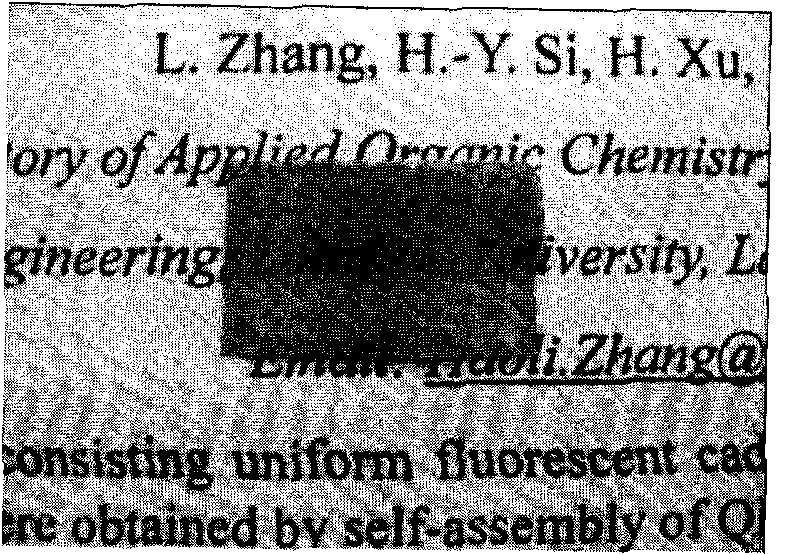Method for preparing titanium dioxide nanotube membrane
A technology of titanium dioxide and nanotubes, applied in nanostructure manufacturing, nanotechnology, nanotechnology, etc., can solve problems affecting special applications, difficulty in ultrasonic power and application time, difficulty in obtaining titanium dioxide nanotube films, etc., to achieve wide application, Improved photocatalytic performance and rapid solution exchange
- Summary
- Abstract
- Description
- Claims
- Application Information
AI Technical Summary
Problems solved by technology
Method used
Image
Examples
Embodiment 1
[0015] The pure titanium plate was cut into a substrate with a size of 3.0 cm × 1.0 cm and a thickness of 250 μm, which were ultrasonically cleaned with acetone, isopropanol, methanol and deionized water in sequence, and then cleaned in HF and HNO 3 Chemical polishing in a mixed solution with a volume ratio of 1:8, N 2 Dry and set aside. At room temperature, with a titanium sheet as the anode and an aluminum sheet as the counter electrode, take 85ml (NH 4 F(0.25wt%)+H 2 O(0.3vol%)+HOCH 2 CH 2 OH) electrolyte, after applying a constant voltage of 60V for anodic oxidation for 2 hours, the surface of the titanium substrate will produce a titanium dioxide layer with a predetermined thickness, and then reduce the oxidation voltage at a rate of 1V / 15s to continue oxidation. After 0, reapply a pulse high voltage of 80V to continue oxidation for 6min, and the titanium dioxide film can fall off from the substrate by itself. Take out the sample sheet and wash it with deionized wate...
Embodiment 2~4
[0017] Similar to Example 1, the difference is that the pure titanium plate is cut into a substrate with a size of 3.0 cm × 1.0 cm and a thickness of 250 μm, which is cleaned with acetone, isopropanol, methanol and deionized water in sequence, and then cleaned in HF and HNO 3 Chemical polishing in a mixed solution with a volume ratio of 1:8, N 2 Dry and set aside. At room temperature, with a titanium sheet as the anode and an aluminum sheet as the counter electrode, take 85ml (NH 4 F(0.25wt%)+H 2 O(0.3vol%)+HOCH 2 CH2 OH) electrolyte solution, apply a voltage of 60V for anodic oxidation for 2h. Thereafter, the oxidation voltage gradually decreased from 60V at intervals of 1V / 15s until the voltage was 1V, and finally applied another 65V (example 2), 70V (example 3), 75V (example 4), and took out the sample and cleaned it with deionized water , air dry. image 3 For the TiO that obtains according to embodiment example 2 2 Scanning electron microscope (SEM) photographs of n...
Embodiment 5~7
[0018] Embodiments 5 to 7: Similar to Embodiment 1, the difference is that the pure titanium plate is cut into a substrate with a size of 3.0 cm × 1.0 cm and a thickness of 250 μm, and is cleaned sequentially with acetone, isopropanol, methanol and deionized water , then in HF and HNO 3 Chemical polishing in a mixed solution with a volume ratio of 1:8, N 2 Dry and set aside. At room temperature, with a titanium sheet as the anode and an aluminum sheet as the counter electrode, take 85ml (NH 4 F(0.25wt%)+H 2 O(0.3vol%)+HOCH 2 CH 2 OH) electrolyte solution, apply a voltage of 60V for anodic oxidation for 2h. Thereafter, the oxidation voltage was gradually reduced from 60V at intervals of 1V every 15s until the voltage was 1V, and finally an 80V pulse high voltage oxidation was applied for 10s (Example 5), 30s (Example 6), and 90s (Example 7). Figure 4 For the corresponding obtained TiO 2 Scanning electron microscope (SEM) photographs of nanotube films. It can be seen fr...
PUM
| Property | Measurement | Unit |
|---|---|---|
| thickness | aaaaa | aaaaa |
| thickness | aaaaa | aaaaa |
Abstract
Description
Claims
Application Information
 Login to View More
Login to View More - R&D
- Intellectual Property
- Life Sciences
- Materials
- Tech Scout
- Unparalleled Data Quality
- Higher Quality Content
- 60% Fewer Hallucinations
Browse by: Latest US Patents, China's latest patents, Technical Efficacy Thesaurus, Application Domain, Technology Topic, Popular Technical Reports.
© 2025 PatSnap. All rights reserved.Legal|Privacy policy|Modern Slavery Act Transparency Statement|Sitemap|About US| Contact US: help@patsnap.com



